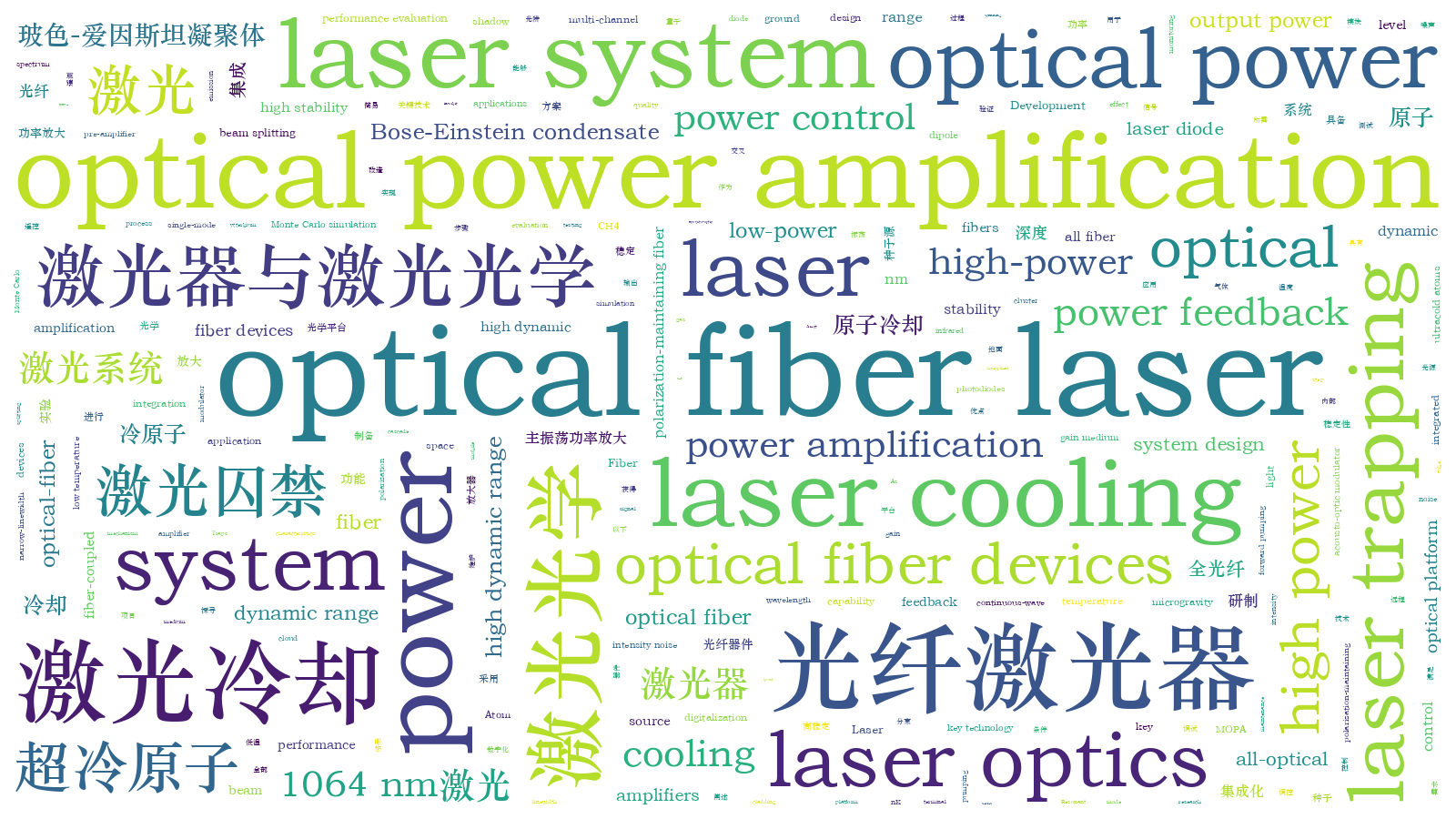超冷原子冷却用集成全光纤1064 nm激光系统的研制  下载: 725次封面文章
下载: 725次封面文章
Deep cooling is a key step in the preparation of ultracold atoms and a key technology for exploring extremely low temperatures. To rule out the effect of gravity, scientists combined microgravity experiments with atomic cooling experiments to get even colder temperatures below 1 nK. The Cold Atom Physics Research rack in the Chinese space station will adopt the deep cooling scheme of all-optical two-stage cooling (TSC) proposed by Chen Xuzong's research group at Peking University. In this scheme, two pairs of 1064 nm Far-Off Resonant optical-dipole Traps (FORTs) are used to successively cool 87Rb atomic cloud by evaporative cooling and adiabatic expansion cooling. According to a direct Monte Carlo simulation, it is concluded that ultracold atomic gas below 100 pK can be obtained in microgravity environments by TSC process. In order to cover the experimental requirements in orbit, we develop a set of integrated optical-fiber 1064-nm laser system. This system provides four high power, high dynamic range, and low relative intensity noise (RIN) 1064-nm infrared channels, with full digitalization, high integration, high stability, and easy maintenance, which fully meets the application requirements of the space station and other remote-control projects.
The system adopts beam splitting amplification scheme, namely, "pre-amplifiers+beam splitters +power controlling+post-amplifiers", to carry out multi-channel, high-power amplified, and high-dynamic range-controlled laser sources which is generated from a single seed light.
This laser system composed of polarization-maintaining fiber devices, as shown in Fig. 1, can be divided into two stages. The first stage, "high-quality seed source", as shown in left purpure shadow of Fig. 1, consists of three parts: a seed source, a high-gaining pre-amplifier (PA), and cascade fiber beam splitters, and it is used to provide stable and narrow-linewidth seed light required by the subsequent optical operations. The other stage, "high-power amplification", as shown in right shadow of Fig. 1, consists of two components: a power control level, consisting of boost amplifiers (BO) and fiber-coupled acousto-optic modulator (AOM), and a power monitoring level, consisting of terminal photodiodes, and it plays the role of amplifying, output controlling, and power feedback, so that the output signals meet the experimental requirements in terms of high power, high dynamic range, high stability, and low RIN. From the left to right in Fig. 1, the continuous-wave seed signal, coming from a single-mode narrow 1064-nm laser tube, is sequentially amplified, filtered, split, and controlled within this full-functional optical platform to generate four 1064-nm FORTs, CH1-CH4, where CH1 and CH2 are called as high-power thin-waisted FORTs, and CH3 and CH4 are named after low-power wide-waisted FORTs.
As for the design of amplifiers, our laser adopts the full-fiber Master Oscillation Power Amplifier (MOPA) scheme to enlarge the optical power, where ytterbium-doped fibers (YDFs) with emission band from 1000 nm to 1100 nm are selected as the gain medium in the application of 87Rb TSC and a 976-nm wavelength-locked laser diode is used for cladding forward pumping of these YDF. Both of PA and BOs are adopted a one-level MOPA scheme, as present in Fig. 2, to amplify and control the gained beams. With these amplifiers and power feedback mechanism, the laser system has capability of producing multi-channel laser with high power and low noisy, which satisfies the TSC experimental requirements.
We run a series of tests to evaluate the performance of the laser system in terms of output power, spectrum, stability, RIN, etc. and conduct ground-based TSC pre-experiments to verify the overall system design in real experimental environments. The results show that this system has realized two 5-W and two 160-mW optical power independent output channels, has performed its capability of 60-dB high power-scanning dynamic range, as shown in Table 1, and has reduced the RIN as low as 5×10-4, as demonstrated in Fig. 6. In the subsequent ground TSC experiments, we have obtained an ultra-cold 87Rb atomic cluster with an extreme-low temperature of 10 nK, which is much lower than the cooling temperature in general all-optical evaporative cooling, and the experimental results are presented in Fig. 7 in details. All the tests and experiments indicate that our laser system reaches the overall performance requirements and is competent in future in-orbit TSC experiments.
In this paper, we describe in detail the development and testing of an integrated all fiber 1064-nm laser system for 87Rb atomic deep cooling. The system uses all optical fiber devices to realize the functions of seed source, optical power amplification, and optical power feedback controlling. It has the characteristics of digitalization and integration, and it is suitable for various applications of ultracold atoms with mobile requirements. The performance evaluation and experimental results prove that the laser system fully meets the power, control, and stability requirements of the TSC deep cooling experiments on four beams of optical dipole traps. This laser system has been installed in the Cold Atom Physics Research rack in Chinese Space Station, has been launched in October 2022, and plays an important role in ultracold physics researches in orbit.
谢昱, 梁昂昂, 李文文, 黄名山, 汪斌, 刘亮. 超冷原子冷却用集成全光纤1064 nm激光系统的研制[J]. 光学学报, 2023, 43(1): 0114001. Yu Xie, Ang′ang Liang, Wenwen Li, Mingshan Huang, Bin Wang, Liang Liu. Development of Integrated All-Fiber 1064 nm Laser System for Ultracold Atomic Cooling[J]. Acta Optica Sinica, 2023, 43(1): 0114001.







